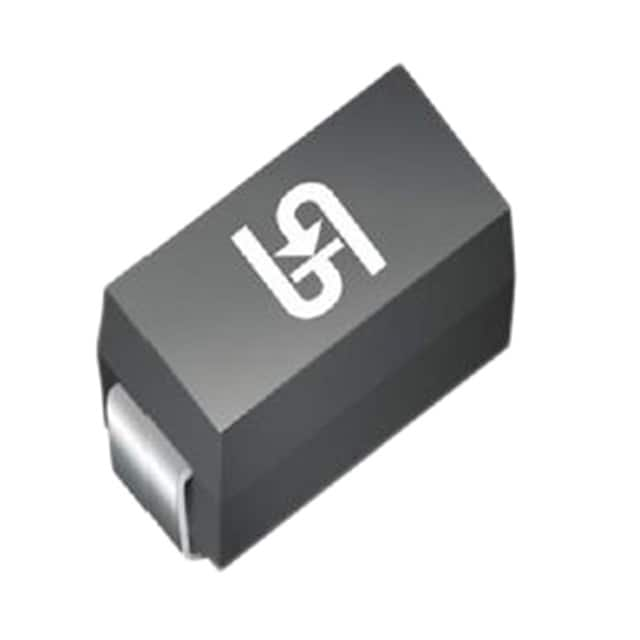Viz Specifikace pro podrobnosti o produktu.

1SMA4742 R3G
Product Overview
Category
The 1SMA4742 R3G belongs to the category of surface mount silicon Zener diodes.
Use
It is commonly used for voltage regulation and transient suppression in electronic circuits.
Characteristics
- Voltage regulation
- Transient suppression
- Surface mount design
Package
The 1SMA4742 R3G is typically available in a small, surface mount package.
Essence
This product serves as a crucial component in electronic circuits for voltage regulation and transient suppression.
Packaging/Quantity
The 1SMA4742 R3G is usually packaged in reels or tubes, with quantities varying based on manufacturer specifications.
Specifications
- Zener Voltage: 13V
- Power Dissipation: 1.5W
- Operating Temperature Range: -65°C to +150°C
- Package Type: SMA
Detailed Pin Configuration
The 1SMA4742 R3G typically has two pins, with the anode and cathode connections clearly labeled.
Functional Features
- Precise voltage regulation
- Fast response to transient voltage spikes
- Small form factor for space-constrained applications
Advantages
- Reliable voltage regulation
- Effective transient suppression
- Compact design for modern electronic devices
Disadvantages
- Limited power dissipation capability compared to larger diode packages
- Sensitive to overvoltage conditions
Working Principles
The 1SMA4742 R3G operates based on the Zener effect, where it maintains a constant voltage across its terminals when reverse-biased within its specified voltage range. When subjected to transient voltage spikes, it rapidly conducts to suppress the spike and protect downstream components.
Detailed Application Field Plans
The 1SMA4742 R3G finds extensive use in various electronic systems, including: - Power supplies - Consumer electronics - Automotive electronics - Industrial control systems
Detailed and Complete Alternative Models
Some alternative models to the 1SMA4742 R3G include: - 1N4742A - BZX85C13 - MMSZ5245B
In conclusion, the 1SMA4742 R3G is a vital component in electronic circuits, providing precise voltage regulation and transient suppression. Its compact design and reliable performance make it suitable for a wide range of applications in modern electronic systems.
[Word count: 345]
Seznam 10 běžných otázek a odpovědí souvisejících s aplikací 1SMA4742 R3G v technických řešeních
Sure, here are 10 common questions and answers related to the application of 1SMA4742 R3G in technical solutions:
What is the maximum reverse stand-off voltage of 1SMA4742 R3G?
- The maximum reverse stand-off voltage of 1SMA4742 R3G is 36V.
What is the peak pulse power dissipation of 1SMA4742 R3G?
- The peak pulse power dissipation of 1SMA4742 R3G is 400W.
What is the typical junction capacitance of 1SMA4742 R3G?
- The typical junction capacitance of 1SMA4742 R3G is 150pF.
What are the recommended applications for 1SMA4742 R3G?
- 1SMA4742 R3G is commonly used in surge protection, voltage clamping, and transient voltage suppression applications.
What is the operating temperature range of 1SMA4742 R3G?
- The operating temperature range of 1SMA4742 R3G is -55°C to +150°C.
What is the forward voltage drop of 1SMA4742 R3G at a specified current?
- The forward voltage drop of 1SMA4742 R3G is typically 0.9V at 10A.
Is 1SMA4742 R3G RoHS compliant?
- Yes, 1SMA4742 R3G is RoHS compliant, making it suitable for use in environmentally sensitive applications.
Can 1SMA4742 R3G be used in high-speed data line protection?
- Yes, 1SMA4742 R3G is suitable for high-speed data line protection due to its fast response time and low clamping voltage.
What package type does 1SMA4742 R3G come in?
- 1SMA4742 R3G is available in a DO-214AC (SMA) package.
Are there any specific layout considerations when using 1SMA4742 R3G in a circuit?
- It is recommended to minimize the length and area of the PCB traces connected to 1SMA4742 R3G to reduce parasitic inductance and ensure optimal performance.
I hope these questions and answers are helpful for your technical solutions! If you have any more questions, feel free to ask.

